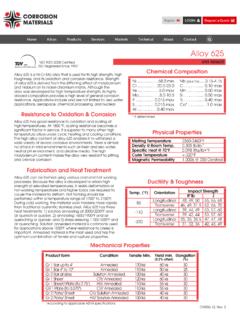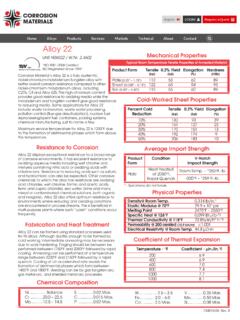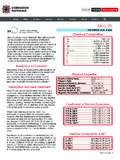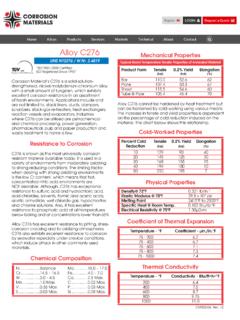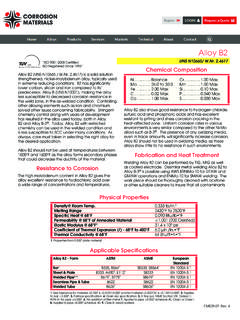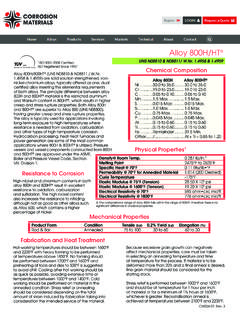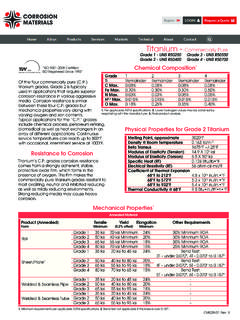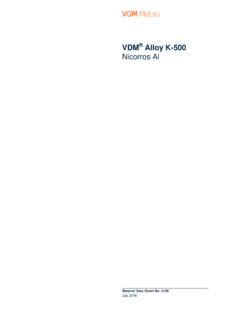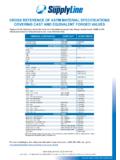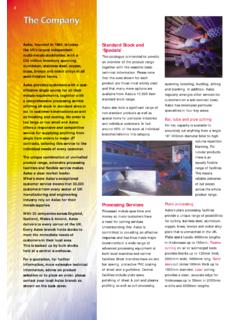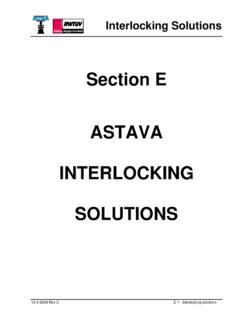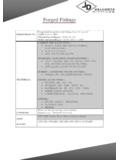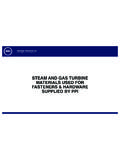Transcription of Applicable Specifications - Corrosion Materials
1 alloy k500 , commonly referred to as K-Monel , is a precipitation hardenable, nickel-copper alloy with similar Corrosion resistance to that of Alloy 400 but with greater strength. Typical industrial applications for alloy k500 include fasteners, springs and chains for marine service, pump and valve components for chemical processing facilities as well as blades and scrapers used in pulp and paper production. Oil and gas production utilize alloy k500 for drill collars, instruments, pump shafts, impellers and valves as well as for sensors and electronic Composition Ni.
2 Mn .. Max. Cu ..Remainder Fe .. Max. Al .. S .. Max. Ti .. Si .. Max. C .. to CorrosionThe Corrosion resistance of alloy k500 is virtually the same as Alloy 400 with exception when in the age-hardened condition, alloy k500 is more susceptible to stress- Corrosion cracking in certain environments. Resistance to hydrogen sulfide makes alloy k500 useful in sour-gas environments making it extremely popular in the oil patch. Low Corrosion rates in sea water make alloy k500 suitable for marine service although pitting may occur in stagnant waters but the rate of pitting slows after initial and Heat TreatAlloy k500 can be fabricated by using standard commercial procedures.
3 Hot working the alloy should be performed at temperatures between 1600 F and 2100 F avoiding any prolong soaking time at the higher temperatures. Material should be water quenched from a temperature no lower than 1450 F after hot working. Cold forming in the annealed condition can also be performed using standard methods although may require considerable power to form. Machining of alloy k500 is easiest in the annealed condition therefore alloy k500 ISO 9001-2008 CertifiedISO Registered Since 1993 Density@ Room Temp. Point 2400 F to 2460 FSpecific Heat1 @ 70 F Btu/lb FLinear Expansion from 70 F to 200 F FLinear Expansion from 70 F to 400 F FLinear Expansion from 70 F to 600 F FThermal Conductivity1 @ 70 F Btu/ft h FMagnetic Permeability2 @ 70 F @ 200 oerstedCurie for Permeability of -153 FPhysical PropertiesCM022-06, Rev.
4 41. Material annealed prior to test. 2. Material annealed and best practice would be to machine oversize, age-harden, then finish to size. Contraction can occur during aging and in/in should be accounted for in size prior to aging. Welding alloy k500 is best achieved by gas-tungsten-arc-welding (GTAW). Filler metal AWS ERNiCu-7 is typically used for joining. Weldments using this filler metal will not have the strength compared to age hardened base metal. For weldments that require strength, AWS ERNiFeCr-2 filler metal can be annealing of the alloy should be performed prior to aging to dissolve phases in the structure that may have formed during previous processing.
5 If the material is hot-finished, then the anneal temperature should be 1800 F. If the material was cold worked, the temperature should be 1900 F. Time at temperature should be kept at a minimum to avoid excessive grain growth. Quenching in water immediately after solution annealing will avoid any partial precipitation of age hardening constituents. Age hardening of annealed (soft) material to obtain maximum properties should be performed as follows. Heat material between 1100 F & 1125 F and hold temperature for 16 hours followed by furnace cooling at a rate of 15 F to 25 F per hour until the material reached a temperature of 900 F.
6 Once the material reached 900 F, cooling can continue via furnace cooling, air cooling or N05500 / to the QQ-N-286 Rev. E requirements for Oil & Gas applications as well as the QQ-N-286 Rev. F & G requirements for Marine k500 British Standard Federal Specification European StandardRod & Bar1,2 BS 3076-NA18 QQN2863, 4 EN BS 3075-NA18 QQN2864 EN SpecificationsThe data and information contained in this pamphlet have been taken from open literature and is believed to be reliable. The information contained is intended to be used as a guide.
7 Corrosion Materials does not make any warranty or assume any legal liability for its accuracy, completeness or Magnetic permeability maximum @ 200 Oe in room temperature. 2. Bar condition may be Hot-Finished/Aged, Cold-Drawn/Aged, Hot-Finished/Annealed/Aged or Cold-Drawn/Annealed/Aged. 3. Revision E, Interim Amendment II, Form Material made to QQ-N-286 Revision G requires slow strain rate tensile testing to the parameters specified in Sections , and Each test is subject to evaluation under Section and requires fracture surface photography to be reported with all material test reports.
8 Material made to QQ-N-286 Revision E is not subject to this type of machine and weld facilities help insure that the most common items will be in stock. Items not in stock can be fabricated in a short period of time either in-house or through our extensive, approved subcontractor and supplier contact Corrosion Materials for a complete list of available items from , Rev. 4 Mechanical Properties at Room TemperatureCondition Maximum Deflection at Tensile ElongationStrength Maximum Strength StrengthAnnealed ksi ksi ksi %Annealed/Aged ksi ksi ksi %Shear StrengthProduct Form Condition Tensile Yield Elongation Hardness(ksi)(ksi)(%)
9 Rod and Bar Hot-Finished/Aged1 140 to 190 100 to 150 30 to 20 27 to 38 HRCRod and Bar Hot-Finished/Annealed 90 to 110 40 to 60 45 to 25 75 to 90 HRBRod and Bar Hot-Finished/Annealed/Aged1 130 to 165 85 to 120 35 to 20 24 to 35 HRCRod and Bar Cold-Drawn/Aged 135 to 185 95 to 160 30 to 15 25 to 41 HRCRod and Bar Cold-Drawn/Annealed/Aged 130 to 190 85 to 120 30 to 20 24 to 35 HRCP late Hot-Finished/Aged 140 to 180 100 to 135 30 to 20 27 to 37 HRCS heet Cold-Rolled/Annealed 90 to 105 40 to 65 45 to 25 85 HRB Nominal properties of material aged to produce maximum properties.
10 Form & Condition Fatigue Strength Tensile Strength Ratio@ 108 cycles (Fatigue Strength/Tensile Strength)Rod - Annealed 38 ksi 88 ksi - Hot-Rolled 43 ksi 99 ksi - Hot-Rolled/Aged 51 ksi 155 ksi Strength at Room TemperatureShanghaiRoom 1202333 Jiujiang Road Shanghai, China 200001 86-21-6045 2221/2223 Fax: 86-21-6045 2225 Baker2262 Groom Box 630 Baker, Louisiana 70714(800) 535-8032(225) 775-3675 FAX: (225) 774-0514 Houston12305 Cutten , Texas 77066(800) 455-2276(713) 939-0364 FAX: (713) Emergency ServicePricing & Documents Available on Our WebsiteChicago375 W.
